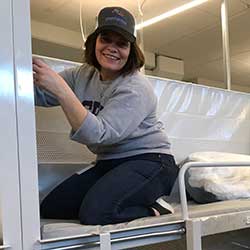Q & A with Chris Michels, Director of Housing Stability and Opportunity

Initially, there was a lot of fear and uncertainty. We didn’t have access to sufficient PPE. That people kept showing up to work is still a head-scratcher! Through adherence to protocols, we kept clients, staff, and volunteers safe—with low client positivity rates. Now that adrenaline is wearing off, exhaustion has set in. Unprecedented funding allowed us to keep vulnerable clients healthy and safe in hotels, but those resources are drying up. We have to repopulate shelters again and are, consequently, seeing more infections.
Q: How has the team responded?
Because of staff commitment to our clients, our doors have been open every day since the pandemic began. Staff are the front lines who call first responders. Like in hospitals, we interact closely with individuals, leaving us vulnerable to staff shortages. We have essentially operated in a trauma bubble, and that is not sustainable for anyone.
Q: How have clients faced these challenging times?
Without food or a place to stay warm, Covid has become just one more thing to persevere through. But people recognize life is harder and look out for each other. Unfortunately, clients have lost normal day-to-day interactions, many don’t operate in a virtual world, so they’re even more isolated. With Covid disrupting access to medical care and treatment, we’re also seeing an increase in physical, mental and chemical health needs.
Q: What are some of the biggest lessons learned?
Through collaboration with nonprofit and government partners, we’ve accomplished amazing things. We set up shelters where guests had a room with a door—where they could stabilize. We opened isolation centers. We hired teams to get people into housing. Covid also showed what was not working well. Homeless response systems are underfunded, and federal funds allowed us to use approaches that better met the needs of clients. Outcomes demonstrate that these new tactics worked. When we band together to focus on solutions we can accomplish a lot more!
Media Relations Manager